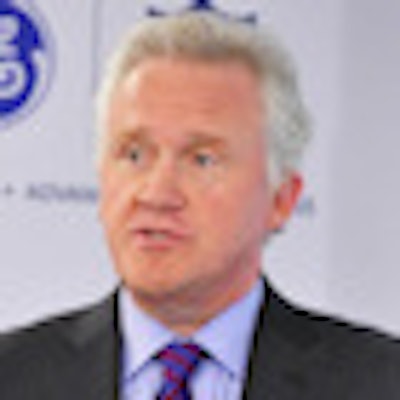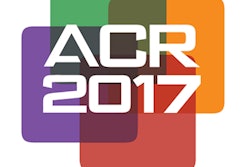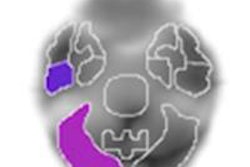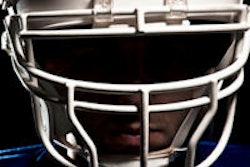
NEW YORK CITY - With the goal of improving the safety of athletes, members of the U.S. Armed Forces, and society overall, GE Healthcare and the National Football League (NFL) have launched a $60 million program aimed at speeding the diagnosis of and improving treatment for mild traumatic brain injury.
GE and NFL executives shared details of the Head Health Initiative during a Monday afternoon press conference at Rockefeller Center in Manhattan. As part of the $60 million program, a four-year, $40 million research and development effort will evaluate and develop next-generation imaging technologies to improve diagnosis and enable targeted treatment for patients with mild traumatic brain injury, according to GE and the NFL.
In addition, GE, the NFL, and sports apparel company Under Armour are investing a total of $20 million to fund two $10 million challenges, one focused on identifying new methods for diagnosing and improving the prognosis of patients with mild traumatic brain injuries and the other on preventing such injuries.
The Head Health Initiative will take a whole-brain approach to determine key MRI biomarkers for potential diagnosis, outcome prediction, and therapy management for patients with mild traumatic brain injury, according to the companies.
 Jeff Immelt, GE chairman and CEO.
Jeff Immelt, GE chairman and CEO.
"Neurology is going to be the big area of scientific research over the next five to 10 years," said Jeff Immelt, GE chairman and CEO. "New technology is increasingly focused on diseases that have to do with neurology: Alzheimer's disease, Parkinson's disease, and traumatic brain injury. The World Health Organization says that by 2020, diseases of the brain will be the leading source of health expenditures. This is a tremendously important field for technology research."
NFL Commissioner Roger Goodell said that the NFL has given millions of dollars for research projects being undertaken by the U.S. National Institutes of Health. "Our goal is to better diagnose, treat, and prevent brain injury," he said. "We have made an impact on the safety of other sports, and we want to speed up that process."
Goodell and the owners of six NFL football franchises said they are participating in the Head Health Initiative to use clinical, engineering, and research expertise to accelerate diagnostic tools that will help identify concussions at an earlier stage.
"We want to work with anyone who will help us develop ways to protect the brain," Goodell said.
The two $10M challenges
The first challenge, regarding proposals for technologies and imaging biomarkers to help identify and manage subclinical and mild traumatic brain injury, was launched with Monday's press conference.
The challenge will cover the following areas:
- Development and validation of imaging and/or sensor-based biomarkers that can aid the diagnosis and prognosis of mild traumatic brain injury events
- Development of new technologies that are more sensitive to small contusions and injuries missed by current technologies
- Improved algorithms for quantifying and visualizing markers of brain injury severity and longitudinal change
- Algorithms and tools that link imaging data to clinical, cognitive, and biomechanical data
- Models of individual risk and long-term prognosis, and clinical decision-support tools using population studies
- Robust methods for triaging acute stage events and developing guidelines for "return to play" using physiological, molecular, electrical, or physical changes in the brain or body function
The second challenge will be launched in the fall of 2013. This $10 million challenge will invite proposals for new materials and technologies that can protect the brain from traumatic injury. It also will include proposals for new tools for tracking head impacts in real-time. The specific focus areas for this challenge include systems that monitor and integrate directional and rotational impact forces; these systems should integrate with imaging/diagnostic equipment, according to the companies.
The winners of the challenges will be selected by a panel of external judges. A website for the challenges has been established.
In addition to GE's research staff, a cross-disciplinary team of medical experts in brain injury will serve as an advisory board for the Head Health Initiative. Appointees to the advisory board include the following:
- Dr. Richard Ellenbogen, chief of the division of neurosurgery at Seattle Children's Hospital and co-chair of the NFL's head, neck, and spine medical committee
- Colonel Dr. Jaime Grimes, national director of the Defense and Veterans Brain Injury Center
- Dr. Brian Hainline, chief medical officer of the National Collegiate Athletic Association (NCAA)
- Dr. Larry Leverenz, director of athletic training education at Purdue University and president of the World Federation of Athletic Training and Therapy
- Dr. Russell Lonser, chair of the department of neurological surgery at Ohio State University Wexner Medical Center, and a member of the NFL's head, neck, and spine medical committee
- Dr. Geoffrey Manly, PhD, professor of neurosurgery at the University of California, San Francisco (UCSF)
- Dr. Thomas McAllister, professor of psychiatry and neurology at Dartmouth University's Geisel School of Medicine
- Dr. Pratik Mukherjee, PhD, associate professor of radiology and biomedical imaging at UCSF
- Dr. Teena Shetty, a neurologist at the Hospital for Special Surgery
- Lieutenant Colonel Dr. Gerald York, a neuroradiologist at Brooke Army Medical Center



.fFmgij6Hin.png?auto=compress%2Cformat&fit=crop&h=100&q=70&w=100)




.fFmgij6Hin.png?auto=compress%2Cformat&fit=crop&h=167&q=70&w=250)











